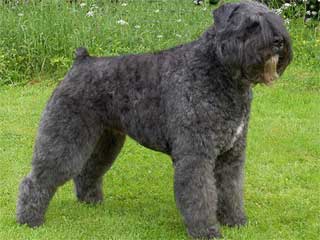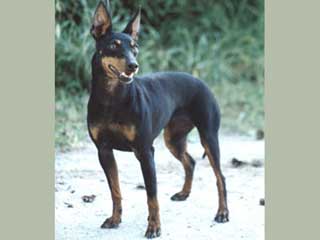| Grooming: |  |  |  |  |  |  |
| Shedding: |  |  |  |  |  |  |
| Energy Level: |  |  |  |  |  |  |
| Protection: |  |  |  |  |  |  |
| Watch Dog: |  |  |  |  |  |  |
| Group: | Herding |
| Size: | Large |
| Life Span: | 10-12 years |
| Height: | Male: 24-28 inches |
| Female: 23-27 inches | |
| Weight: | Male: 70-100 lbs |
| Female: 60-80 lbs |
Bouvier Des Flandres Facts
| Coat : | Outercoat is rough. Undercoat is soft, dense and fine. |
| Gait : | Free and energetic |
| Color(s) : | Fawn, black, grey and brindle |
| Living Area : | Any |
| Hair Length: | Long |
| Exercise Need : | Daily long walk and jog |
| Recognized By : |
(CKC) Canadian Kennel Club (FCI) F�d�ration Cynologique Internationale (AKC) American Kennel Club (UKC) United Kennel Club (KCGB) Kennel Club of Great Britain (CKC) Canadian Kennel Club (ANKC) Australian National Kennel Council (NKC) National Kennel Club (NZKC) New Zealand Kennel Club (APRI) America Pet Registry, Inc. (ACR) American Canine Registry (DRA) Dog Registry of America |
| Date of Origin : | 19th Century |
| Place of Origin : | Belgium |
| Todays Use : | Farm dog, Guard Dog |
| Originally Used : | Farm dog, Cattle Herding |
| Other Name : | Flanders Cattle Dog, Vlaamse Koehond |
Bouvier Des Flandres Information
Bouvier Des Flandres Description:The origin of the Bouvier des Flandres lies in Flanders, Belgium. The breed is believed to be a result of crossbreeding between the Irish Wolfhound, Scottish Deerhound and the local farm dogs of Belgium. However, certain theories suggest that it is a result of crossbreeding between the Griffon and the Beauceron. Until the earlier part of the 20th century, the breed was recognized as three different variants- Paret, Moerman and Roeselare. However, after the First World War, all three variants were on the brink of extinction. Due to effort of a group of people the breed was resurrected and identified in one name. In the olden days, this dog was primarily used for farm work such as herding and guarding cattle, and hence its name, which is French for cow herder of Flandres. It was first recognized by the AKC in 1931. |
Bouvier Des Flandres Care & Grooming:The Bouvier des Flandres sheds little hair. Its long and rough coat needs extensive grooming. It needs to be brushed almost daily to avoid matting or tangling of the hair. It should be bathed only when necessary and must be dried properly after each bath. Its hair grows continuously so trimming is required in every 3-4 months. Its eyes and ears should be cleaned properly. The hair around the ears, eyes and paws needs to be trimmed regularly. |
Bouvier Des Flandres Health Problems:The Bouvier des Flandres is prone to some health issues like hip Dysplasia, Bloat, Cataract etc. |
| Group: | Sporting |
| Size: | Large |
| Life Span: | 8-10 years |
| Height: | Male: 23-24.5 inches Female: 22-23.5 inches |
| Weight: | Male:60-75 lbs Female: 55-70 lbs |
| Color: | Black or Liver. |
| Description: | The origin of the Flat Coated Retriever lies in England. This breed dates back to t..... |










